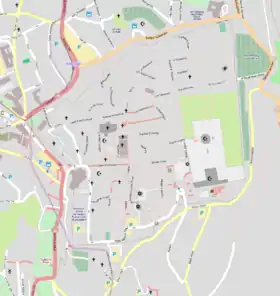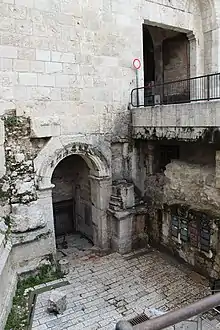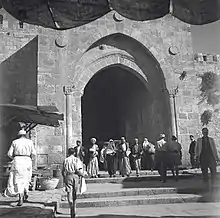Damascus Gate
Damascus Gate (Arabic: باب العامود, romanized: Bāb al-ʿĀmūd, Hebrew: שער שכם, Sha'ar Sh'khem) is one of the main Gates of the Old City of Jerusalem.[1] It is located in the wall on the city's northwest side and connects to a highway leading out to Nablus, which in the Hebrew Bible was called Shechem or Sichem, and from there, in times past, to the capital of Syria, Damascus; as such, its modern English name is Damascus Gate, and its modern Hebrew name, Sha'ar Shkhem (שער שכם), meaning Shechem Gate, or Nablus Gate.[1][2] Of its historic Arabic names, Bab al-Nasr (باب النصر) means "gate of victory," and Bab al-Amud (باب العامود) means "gate of the column."[1] The latter name, in use continuously since at least as early as the 10th century, preserves the memory of a Roman column towering over the square behind the gate and dating to the 2nd century AD.[1][3]
| Damascus Gate | |
|---|---|
 | |
 Location in Old Jerusalem | |
| General information | |
| Town or city | Jerusalem |
| Coordinates | 31°46′53.9″N 35°13′49.8″E |
| Completed | 1537 |
History
In its current form, the gate was built in 1537 under the rule of Suleiman the Magnificent.[1]
Beneath the current gate, the remains of an earlier gate can be seen, dating back to the time of the Roman Emperor Hadrian, who visited the region in 130–131 CE.[4] In the square behind this gate stood a Roman victory column topped by a statue of Emperor Hadrian, as depicted on the 6th-century Madaba Map.[1] This historical detail is preserved in the current gate's Arabic name, Bab el-Amud, meaning "gate of the column".[1] On the lintel of the 2nd-century gate, which has been made visible by archaeologists beneath today's Ottoman gate, is inscribed the city's Roman name after 130 CE, Aelia Capitolina.[1]
Until the latest excavations (1979-1984),[4] some researchers believed that Hadrian's gate was preceded by one erected by Agrippa I (r. 41–44 CE) as part of the so-called Third Wall.[5] However, recent research seems to prove that the gate does not predate the Roman reconstruction of the city as Aelia Capitolina, during the first half of the second century.[4]
Hadrian's Roman gate was built as a free-standing triumphal gate, and only sometime towards the end of the 3rd or the very beginning of the 4th century were there protective walls built around Jerusalem, connecting to the existing gate.
The Roman gate remained in use during the Early Muslim and Crusader period, but several storerooms were added by the Crusaders outside the gate, so that access to the city became possible only by passing through those rooms.[5] Several phases of construction work on the gate took place during the early 12th century (first Crusader Kingdom of Jerusalem, 1099–1187), the early Ayyubid period (1187-1192), and the 13th-century second phase of Crusader rule over Jerusalem.[2]
Damascus Gate is the only Jerusalem gate to have preserved its name, Bab al-Amud, since at least the 10th century.[3] The Crusaders called it St. Stephen's Gate (in Latin, Porta Sancti Stephani), highlighting its proximity to the site of martyrdom of Saint Stephen, marked since the time of Empress Eudocia by a church and monastery.[2][6] A 1523 account of a visit to Jerusalem by a Jewish traveller from Leghorn uses the name Bâb el 'Amud and notes its proximity to the Cave of Zedekiah.[7]

Description
Damascus Gate is flanked by two towers, each equipped with machicolations. It is located at the edge of the Arab bazaar and marketplace in the Muslim Quarter. In contrast to the Jaffa Gate, where stairs rise towards the gate, in the Damascus Gate, the stairs descend towards the gate. Until 1967, a crenellated turret loomed over the gate, but it was damaged in the fighting that took place in and around the Old City during the Six-Day War. In August 2011, Israel restored the turret, including its arrowslit, with the help of pictures from the early twentieth century when the British Empire controlled Jerusalem. Eleven anchors fasten the restored turret to the wall, and four stone slabs combine to form the crenellated top.[8]
Directly below the visible gate there is an older gate, believed to have been built in the early first or second centuries CE.[9][10] Such findings are in keeping with an account in the Midrash Rabba (Eikha Rabba 1:32) which states that Rabban Yohanan ben Zakkai, during the Roman siege of Jerusalem, requested of Vespasian that he spare the westernmost gates of the city (Hebrew: פילי מערבאה) that lead to Lydda (Lod). When the city was eventually taken, the Arab auxiliaries who had fought alongside the Romans under their general, Fanjar, also spared the wall from destruction. The chronicler who brings down the historical record adds: "And it was decreed in heaven that it should never be destroyed, seeing that the Divine Presence dwells in the West."

Archaeology
In 2013, an archaeological survey-excavation was conducted at the Damascus Gate by Zubair Adawi on behalf of the Israel Antiquities Authority (IAA).[11] Excavations have revealed that construction within the Damascus Gate continued under the Byzantine emperor, Justinian I.[12][13]
Culture and literature
Damascus gate is a cultural icon in much of Palestinian literature and culture. It has folkloric and sentimental value to many Palestinians which includes imagery of women selling baladi products and coffee shops in the square.
Nazmi Jubeh, a professor at Birzeit University, said of Damascus Gate, "[It] has become a symbol for the Palestinian national struggle because of its accessibility to Palestinians and the main connecting point for both worshippers and for markets." [14] Damascus Gate has been an ongoing site of violent confrontations between Palestinian terrorists and Israeli soldiers and police.[14] In 2016, there were more than 15 attacks at the gate and the Washington Post published an article entitled "Jerusalem's ancient Damascus Gate is at the heart of a modern wave of violence."[15]

See also
References
- LaMar C. Berrett (1996). Discovering the World of the Bible (3rd ed.). Cedar Fort. p. 61. ISBN 978-0-910523-52-3.
- Adrian J. Boas (2001). Jerusalem in the time of the crusades: society, landscape, and art in the Holy City under Frankish rule (Illustrated, reprint ed.). Routledge. p. 53. ISBN 978-0-415-23000-1.
- David Samuel Margoliouth (2010). Cairo, Jerusalem & Damascus: Three Chief Cities of the Egyptian Sultans. Walter S. S. Tyrwhitt, illustrator. Cosimo, Inc. p. 329. ISBN 978-1-61640-065-1.
- Archaeological Sites in Israel-Jerusalem: The Northern Gate of Aelia Capitolina, on the website of the Israel Ministry of Foreign Affairs, 29 July 1998, retrieved 2 March 2018
- Israel Antiquities Authority, The Damascus Gate Section, accessed January 2016. Quote: "Some researchers believe the gate was first erected at the time of Agrippa I, in the mid first century CE. If so, then the ancient gate structure was incorporated in course of the Third Wall."
- fr:Basilique Saint-Étienne de Jérusalem
- Palestine Exploration Fund (1869). Quarterly statement, Issue 3. The Society. p. 376.
- Mazori, Dalia (16 August 2011). 'הכתר' של שער שכם בי-ם שוחזר מחדש ["The crown" of Damascus Gate in Jerusalem restored]. Nrg Maariv (in Hebrew). Retrieved 17 August 2011.
עתה, בתום עבודות שימור נרחבות, שוחזר הכתר והמבקרים יכולים ליהנות מיפי השער במלוא הדרו.
- Hillel Geva and Dan Bahat, Architectural and Chronological Aspects of the Ancient Damascus Gate Area, Israel Exploration Journal, Vol. 48, No. 3/4, Jerusalem 1998, pp. 225-226
- Bahat, Dan (1998). "Architectural and Chronological Aspects of the Ancient Damascus Gate Area". Israel Exploration Journal. 48 (3/4): 223–235. JSTOR 27926522.
- Israel Antiquities Authority, Excavators and Excavations Permit for Year 2013, Survey Permit # A-6799.
- Mevorach, David (9 October 2018). "The Emperor and Abbot Build Jerusalem". The Israel Museum, Jerusalem. Retrieved 9 Feb 2020.
- Hillel Geva and Dan Bahat, "Architectural and Chronological Aspects of the Ancient Damascus Gate Area", Israel Exploration Journal, Vol. 48, No. 3/4, Jerusalem 1998, pp. 225-226
- Kuttab, Daoud (2016-02-19). "How Damascus Gate became the symbol of the intifada". Al-Monitor. Retrieved 2020-08-31.
- Booth, William; Eglash, Ruth (2016-02-19). "Jerusalem's ancient Damascus Gate is at the heart of a modern wave of violence". Washington Post. ISSN 0190-8286. Retrieved 2020-08-31.
